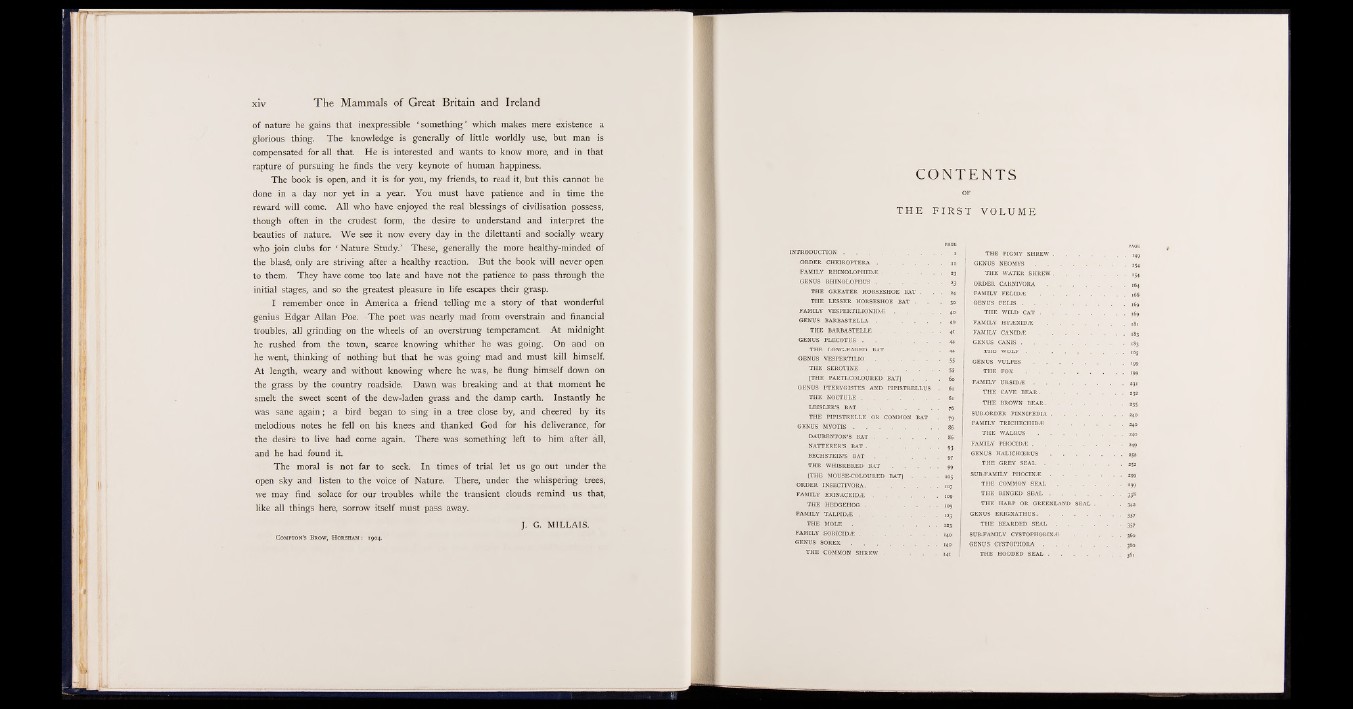
of nature he gains that inexpressible ‘ something’ which makes mere existence a
glorious thing. The knowledge is generally of little worldly use, but man is
compensated for all that. He is interested and wants to know more, and in that
rapture of pursuing he finds the very keynote of human happiness.
The book is open, and it is for you, my friends, to read it, but this cannot be
done in a day nor yet in a year. You must have patience and in time the
reward will come. All who have enjoyed the real blessings of civilisation possess,
though often in the crudest form, the desire to understand and interpret the
beauties of nature. We see it now every day in the dilettanti and socially weary
who join clubs for ‘ Nature Study.’ These, generally the more healthy-minded of
the blasé, only are striving after a healthy reaction. But the book will never open
to them. They have come too late and have not the patience to pass through the
initial stages, and so the greatest pleasure in life escapes their grasp.
I remember once in America a friend telling me a story of that wonderful
genius Edgar Allan Poe. The poet was nearly mad from overstrain and financial
troubles, all grinding on the wheels of an overstrung temperament. At midnight
he rushed from the town, scarce knowing whither he was going. On and on
he went, thinking of nothing but that he was going mad and must kill himself.
At length, weary and without knowing where he was, he flung himself down on
the grass by the country roadside. Dawn was breaking and at that moment he
smelt the sweet scent of the dew-laden grass and the damp earth. Instantly he
was sane again; a bird began to sing in a tree close by, and cheered by its
melodious notes he fell on his knees and thanked God for his deliverance, for
the desire to live had come again. There was something left to him after all,
and he had found it.
The moral is not far to seek. In times of trial let us go out under the
open sky and listen to the voice of Nature. There, under the whispering trees,
we may find solace for our troubles while the transient clouds remind us that,
like all things here, sorrow itself must pass away.
J. G. M IL L A IS .
Compton’s Brow, Horsham : 1904.
CONTENTS
OF
T H E F I R S T V O L U M E
INTRODUCTION.......................................................... ........ I
ORDER CHEIROPTERA............................................ij j
FAMILY RHINOLOPHIDAJ........................................ 23
GENUS RHINOLOPHUS............................................23
THE GREATER HORSESHOE BAT . . . 24
THE LESSER HORSESHOE BAT . . 30
FAMILY VESPERTILIONID/E.................................40
GENUS BARBASTELLA............................................40
THE BARBASTELLE........................................ 4,
GENUS PLECOTUS................................................... 44
THE LONG-EARED B A T .................................44
GENUS VESPERTILIO............................................55
THE SEROTIN E................................................ 55
[THE PARTI-COLOURED BAT] . . . 60
GENUS PTERYGISTES AND PIPISTRELLUS - 6x
THE NOCTULE . . . i . . . 61
LEISLER’S B A T ........................................... . 76
THE PIPISTRELLE OR COMMON BAT 79
GENUS MYOTIS........................................................86
DAUBENTON’S B A T ....................................... 8 6
NATTERER’S BAT................................................ 93
BECHSTEIN’S BAT . - 9 7
THE WHISKERED B A T .................................99
[THE MOUSE-COLOURED BAT] . .10 5
ORDER INSECTIVORA. . ... 107
FAMILY ERINACEID/E.......................................... 109
THE HEDGEHOG...............................................109
FAMILY TALPID/E...................................... ,1 3 3
THE M O L E .......................................................123
FAMILY SORICID^E.................................................. i40
GENUS S O R E X .......................................................i40
THE COMMON SHREW...................................j4i
THE PIGMY SHREW...........................................I49
GENUS N E OM Y S ......................................................IJ4
THE WATER SHREW...........................................,S4
ORDER CA RN IVO RA ..............................................i64
FAMILY F E L I D / E .................................................. l66
GENUS FE L IS ................................................................. 169
THE WILD CAT; . 169
FAMILY B Y A JN ID iE ..................................................,8,
FAMILY C A N ID / E ...................................................... ^3
GENUS CANIS................................................................. 183
THE W O L F ..............................................................185
GENUS VULPES 199
THE F O X ..............................................................,99
FAMILY URSID/E . . . . . . . . 231
THE CAVE BEAR......................................................232
THE BROWN B E A R . ..........................................235
SUB-ORDER PINNIPEDIA.............................................. 24o
FAMILY TR ICHE CHID iE..........................................240
THE WALRUS.........................................................240
FAMILY PHOGIDi'E......................................................249
GENUS HALICHCERUS ...........................................252
THE GREY S E A L ..............................................252
SUB-FAMILY PHOCIN/E.......................................... 299
THE COMMON S E A L ......................................299
THE RINGED S E A L .......................................... 338
THE HARP OR GREENLAND SEAL . . . 342
GENUS ERIGNATHUS. ...........................................357
THE BEARDED S E A L ...................................... 357
SUB-FAMILY CYSTOPHORIN/E............................360
GENUS CYSTOPHORA..............................................360
THE HOODED SEAL ...........................................361